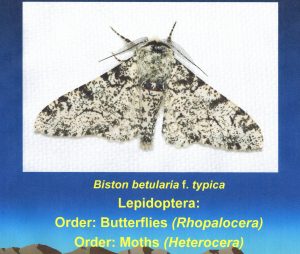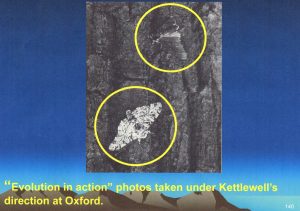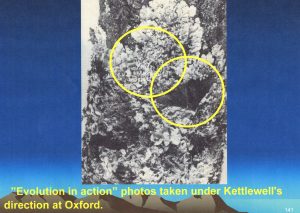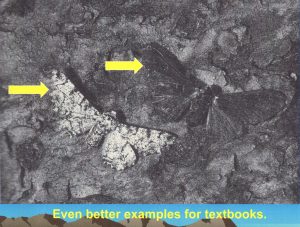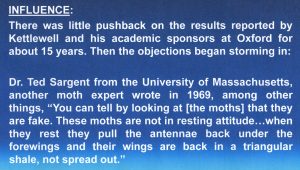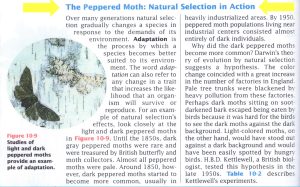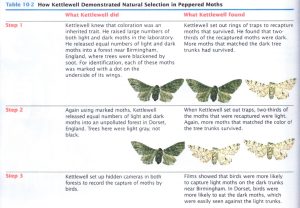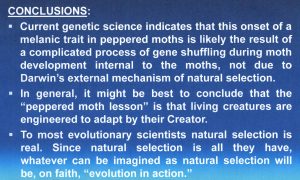This article is based on one section of a PowerPoint presentation that I did for the Design Science Association of Portland in May 2024. The title of the talk was “Evolution’s 14 Greatest Frauds” where Peppered Moths was listed as fraud number 11. Slide number 1 provides background on this fraud.
Slide 1.
By the decade of the 1960s Kettlewell’s peppered moths had conquered all the high school biology textbooks. In my opinion they still continue to pollute the minds of many students with flawed ideas of evolution.
Slide 2.
Slide 3 illustrates a typical peppered moth of the lighter colored variety. The darker colored variety is identified as f. carbonara. It differs from the f. typica due to having more melanin in its wings in a similar manner as human skin color varies due to the amount of melanin. More melanin results in darker skin. Moths and butterflies are scientifically categorized in different orders as seen in slide 3.
Slide 3.
Slide 4 shows the historical story behind the idea of the peppered moths. The story was that in England a population of peppered moths reportedly shifted their coloring from mostly light to mostly dark after soot from the industrial revolution darkened the moths’ tree-trunk homes. Then bird predators had a difficult time seeing the now camouflaged dark moths, so compared to the lighter moths the dark ones flourished.
Slide 4.
Benard Kettlewell (Slide 5) was a medical doctor, husband to his wife, father of two children, the life of the party, and an admitted fanatic about everything to do with moths. In his lifetime and in the present, he is known worldwide for his peppered moth experiments. He set out in the early 1950s to prove Darwin’s theory of evolution. He became known as a great naturalist, but it turned out that he was not a very good scientist.
Slide 5.
Slide 6 lists how Kettlewell went about his experimentation with the moths. There was little, if any, blind work done by him that would have precluded the introduction of bias into his work.
Slide 6.
Slides 7 through 10 are photos that Kettlewell and others promoted in textbooks as showing Darwinian “Evolution in Action.” Some of the moths in the photos were alive, others were dead, but they all were artificially posed in these images. The dark moth varieties show up better on a light tree trunk, and the lighter varieties show up better on a dark tree trunk.
Slide 7.
Slide 8.
Slide 9.
Slide 10.
Slide 11.
The way that Kettlewell had laid out the moths in his photos was not natural and it turned out that he had basically trained the birds to flock to the bird feeders he had designed and then gobble up the moths. Another point emphasized by skeptics of his work was that peppered moths normally rest on the undersides of tree leaves and not on the surfaces of the bark of trees. A number of moth experts began to join in to loudly criticize Kettlewell’s work.
All of these problems and more are skillfully documented in a book published in 2002 by devoted evolutionist author Judith Hooper (see Slide 12). But decades before this book was published the pressure on Kettlewell became unbearable. His hard lifestyle, the suicide of his daughter, various maladies, and the loads of criticisms of his work all brought him to turn to a place of deep depression.
Slide 12.
Unfortunately, Kettlewell’s faulty work still lives in current textbooks. Even the posed photos are republished over and over. See Slide 13 for example.
Slide 13.
So, if you believe that biological adaptation is the same as Darwin’s natural selection, then you will have no problem with the explanations seen in Slides 14 and 15 from the high school text.
Slide 14.
Slide 15.
But please remember that nature is completely dumb and cannot select, and I think a better understanding is that adaptation is the result of the internal design of organisms by the work of God in the beginning, not the external influences of stupid nature. When any living thing encounters a new environmental challenge, it will adapt only as allowed for by the internal capabilities that God had inserted into its genetic makeup in the beginning.
Also notice in Slides 14 and 15 that the textbook makes no mention of the grave scientific errors that were and still are inherent in Kettlewell’s work. This is serious fraudulent science in my opinion. My final conclusions regarding the peppered moth experiments are in Slide 16.
Slide 16.
Thank you for reading this article. May God bless you.
J.D. Mitchell


